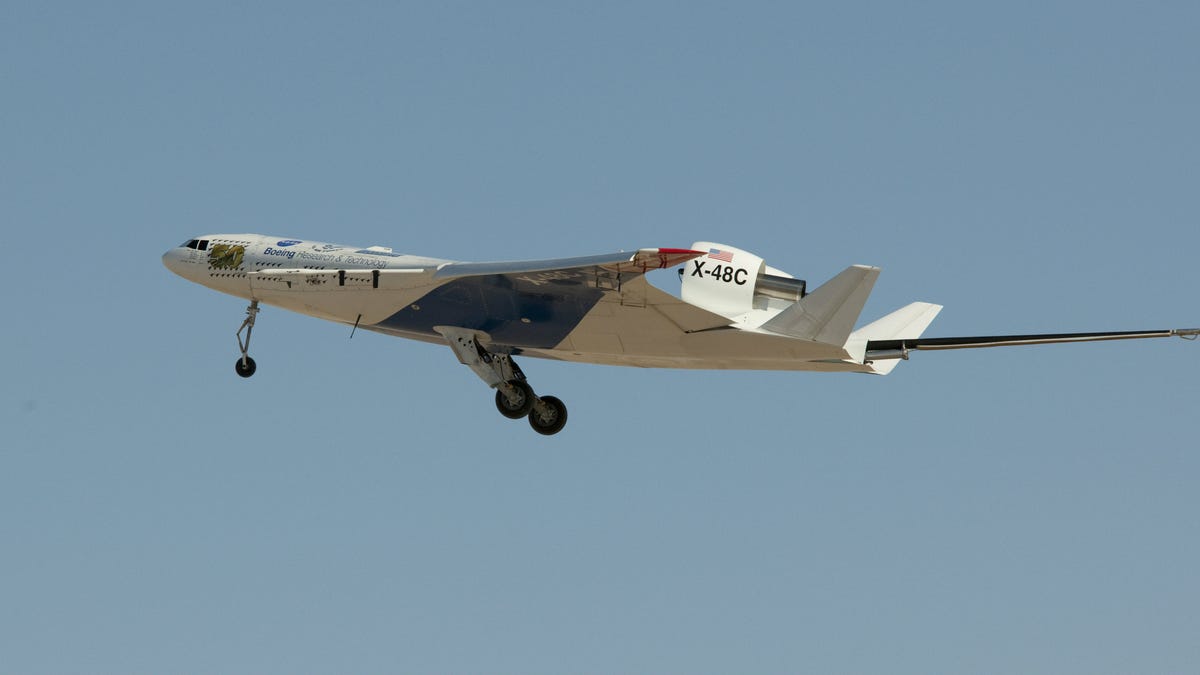Boeing's futuristic X-48C makes final flight
The aerospace giant and NASA say the distinctive "blended wing body" design flew like a champ in low-speed tests and holds promise for quieter, more fuel-efficient aircraft yet to come.

It's mission accomplished for the experimental X-48C aircraft.
The distinctively shaped machine this week made the last of 30 flights in an eight-month program as backers Boeing and NASA sought to show how well a "blended wing body" aircraft can perform. The X-48C program is tied to NASA's Environmentally Responsible Aircraft project, which is geared toward developing futuristic airplanes that burn less fuel, spew fewer emissions, and make less noise.
The Boeing-designed X-48C has a radically different look than that of conventional aircraft. Where a big 747 or a little Cessna has -- very roughly speaking -- the shape of a plus sign when viewed from above or below, with a wings sticking out as separate entities from a long, slender fuselage, the X-48C is essentially a seamless triangle in which there is no separation between wings and fuselage. There's no tail structure, either. Hence the term "blended wing."
"We have shown that a BWB aircraft, which offers the tremendous promise of significantly greater fuel efficiency and reduced noise, can be controlled as effectively as a conventional tube-and-wing aircraft during takeoffs, landings and other low-speed segments of the flight regime," Boeing program manager Bob Liebeck said in a statement Friday.
In the 30 flights since last August, the turbojet-powered, remotely piloted X-48C generally flew for about 30 minutes at a time, going as fast as 140 mph and flying as high as 10,000 feet or so, Boeing said. The scale model aircraft, build by Cranfield Aerospace, has a wingspan of a little more than than 20 feet and weighs about 500 pounds.
Last spring, CNET's Daniel Terdiman got an up-close look at the X-48C at NASA's Dryden Flight Research Center in California, where all the flights would eventually take place. You can read all about that here, or check out the slideshow above.
The X-48C program builds off the earlier research with the similar X-48B design, which made 92 flights over three years ending in 2010. Where the B aircraft had three 50-pound thrust engines, the X-48C has two 89-pound thrust engines. In addition, the aft deck was extended about 2 feet on the C aircraft, and winglets were moved inboard from the wingtips to sit next to the two engines.
Where do the aeronautics engineers go from here? Boeing says that it and NASA hope to build a bigger, faster (transonic -- that is, in the vicinity of the speed of sound) BWB aircraft at some point, and that within 15 to 20 years, the concept could be developed into military aircraft for cargo-carrying and aerial refueling missions. The U.S. Air Force Research Laboratory was also a partner in the project.

